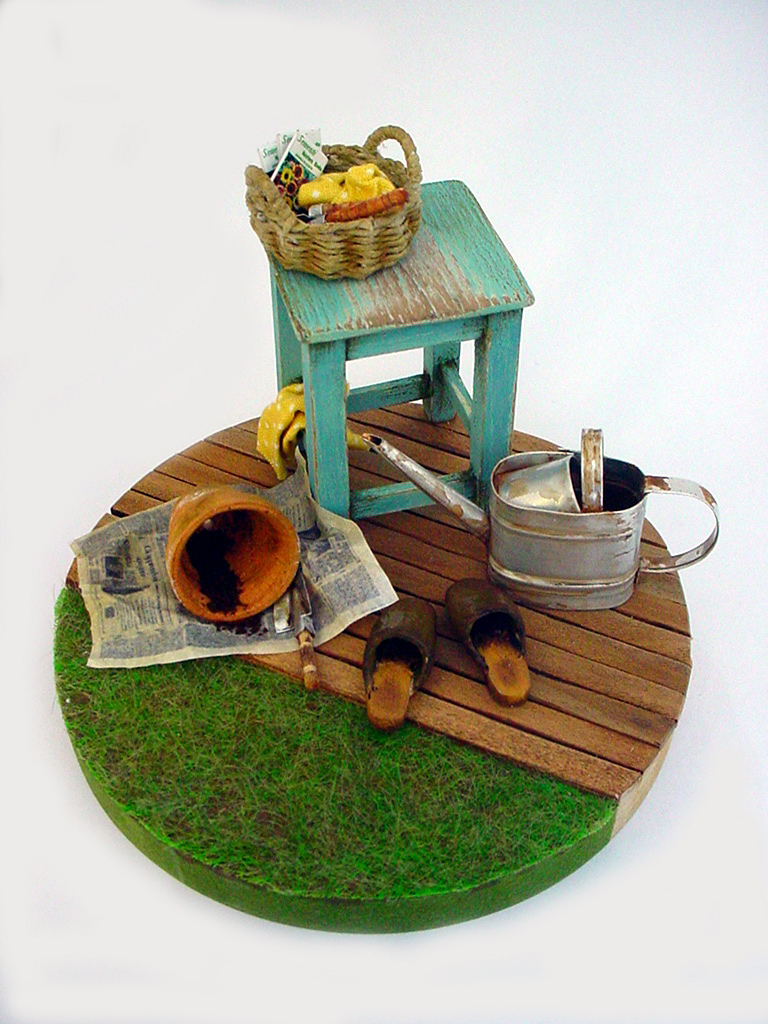
Ten years ago I run this workshop at Tom Bishop’s Chicago International together with Silvia Cucchi. I wish to celebrate this anniversary publishing the watering can tutorial after the basket one, hope you enjoy it!
P.S. sorry for the low pics’ quality , they have 10 years as well.


























STEP 23 –remove the skewer, cut its pointed end, cover it with glue and re-insert it into the spout. This is my trick to strenghten the spout and offer a wider bonding spout surface.

STEP 24 – glue the spout and let the glue dry completely. Sorry for the very low pic quality

STEP 25 – at each step always check if everything is correctly aligned and if not fix it.

STEP 26 – Now take a little bunch of air dry clay, I feel very comfortable with FimoAirLight®, and roll a thick layer.


STEP 28 – remove the outer exceeding clay and let the one inside to dry completely.
HINT – It may happen that after drying the clay tends to shrink a little as it happen to all the air dry clays, no worry, remove the bottom, spread a little bit of glue on its border and then reinsert the bottom. I prefer to do this kind of bottom because most of the times we glue our items in a miniature scene and this kind of bottom offers a very good bonding surface, it helps to make the watering can stronger and, last but not least, it is no tricky at all to make it. Once dried you may paint it in a dark color and no one will notice it is thick.

Once you have learned the process you may apply lot of variations as shown in this pic, these watering cans are the ones I teached in Philadelphia Miniaturia Fair in 2012. As you can see by changing the shape or the aging-texture you may get very nice items to use in your miniature settings
“Miniature Watering Can” di Manuela P. Michieli è distribuito con Licenza Creative Commons Attribuzione – Non commerciale – Condividi allo stesso modo 4.0 Internazionale.
Based on a work at https://manuelamichieli.com/miniature-watering-can-tutorial/
Search:
Categories
- 1:12 scale
- 1:24
- 1:24scale
- Abilmente
- Bambini
- Big Buyer
- Bijoux
- Bookmarks
- Cake Design
- Chicago
- Collaborazioni
- corsi
- Creatività
- Didactica
- Dimostrazioni
- FIMO Consigli Creativi
- HobbyShow
- Miniature
- MiniatureFairs
- Miniaturisti in erba
- Miniaturitalia
- Oggetti Decorativi
- Oggetti utili
- Pasta di zucchero
- Pasta Sintetica – FIMO
- Polymer Clay
- Segnalibro
- STAEDTLER video
- TheItalyStyle
- Topper
- Tutorial
- Uncategorized
- Work In Progress
- Workshop
Archives
- Dicembre 2023
- Ottobre 2023
- Marzo 2021
- Febbraio 2021
- Gennaio 2020
- Ottobre 2019
- Settembre 2019
- Giugno 2019
- Aprile 2019
- Marzo 2019
- Febbraio 2019
- Gennaio 2019
- Dicembre 2018
- Ottobre 2018
- Settembre 2018
- Luglio 2018
- Marzo 2018
- Gennaio 2018
- Dicembre 2017
- Novembre 2017
- Ottobre 2017
- Settembre 2017
- Luglio 2017
- Maggio 2017
- Aprile 2017
- Marzo 2017
- Gennaio 2017
- Dicembre 2016
- Novembre 2016
- Ottobre 2016
- Agosto 2016
- Luglio 2016
- Giugno 2016
- Maggio 2016
- Gennaio 2016



Hi Manuela, where did you buy this foil ..?
– thin metal foil strip-
Please let me know.. thanks
So sorry for my very late answer, had problems in accessing my website for a long time.
This thin foil is used to teach embossing techniques, it is quite cheap and I find it in hobby stores or fine arts shops
I love your pieces! You have a very easy to follow tutorial. What type of glue do you use to bond the metal pieces?
So sorry for my very late answer, had problems in accessing my website for a long time.
I use a gel instant glue like Pattex Super Glue, it is quite flexible and acts like soldering for these tiny pieces.
Whatever instant glue you use the important thing is that it is a gel and remains flexible after drying.
Me gustaría que fueran en español
Lo siento por mi respuesta tardía, tuve problemas para acceder a mi sitio web durante mucho tiempo.
Intentaré agregar español usando el traductor de Google, espero que resulte en una buena traducción ya que no hablo español lo siento
Thank you,i want to meet you …You are good tutor.
Thank you, I run many workshops in these past 35 years and still love doing it expecially with newbies:-)
Tomato paste tubes are perfect to recycle for this project!